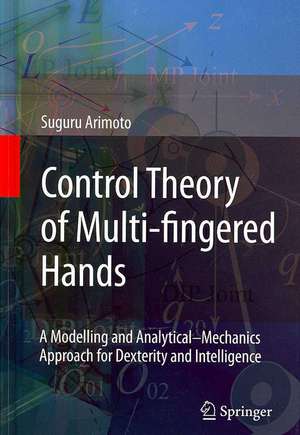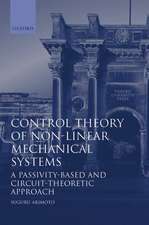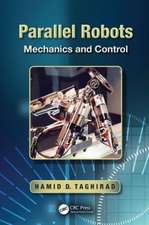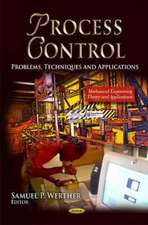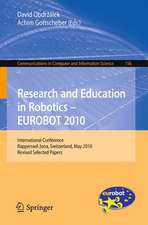Control Theory of Multi-fingered Hands: A Modelling and Analytical–Mechanics Approach for Dexterity and Intelligence
Autor Suguru Arimotoen Limba Engleză Hardback – 17 dec 2007
| Toate formatele și edițiile | Preț | Express |
|---|---|---|
| Paperback (1) | 639.73 lei 6-8 săpt. | |
| SPRINGER LONDON – 13 oct 2010 | 639.73 lei 6-8 săpt. | |
| Hardback (1) | 646.11 lei 6-8 săpt. | |
| SPRINGER LONDON – 17 dec 2007 | 646.11 lei 6-8 săpt. |
Preț: 646.11 lei
Preț vechi: 760.13 lei
-15% Nou
Puncte Express: 969
Preț estimativ în valută:
123.65€ • 128.61$ • 102.08£
123.65€ • 128.61$ • 102.08£
Carte tipărită la comandă
Livrare economică 14-28 aprilie
Preluare comenzi: 021 569.72.76
Specificații
ISBN-13: 9781848000629
ISBN-10: 1848000626
Pagini: 284
Ilustrații: IX, 271 p.
Dimensiuni: 155 x 235 x 20 mm
Greutate: 0.58 kg
Ediția:2008
Editura: SPRINGER LONDON
Colecția Springer
Locul publicării:London, United Kingdom
ISBN-10: 1848000626
Pagini: 284
Ilustrații: IX, 271 p.
Dimensiuni: 155 x 235 x 20 mm
Greutate: 0.58 kg
Ediția:2008
Editura: SPRINGER LONDON
Colecția Springer
Locul publicării:London, United Kingdom
Public țintă
ResearchCuprins
Characterisations of Human Hands.- Stability of Grasping in a Static or Dynamic Sense.- Testbed Problems to Control a 2-D Object Through Rolling Contact.- Two-dimensional Grasping by a Pair of Rigid Fingers.- Three-dimensional Grasping by a Pair of Rigid Fingers.- Dexterity and Control for Stable Grasping by Soft Fingers.
Notă biografică
Dr Suguru Arimoto is a Professor in the Department of Robotics at Ritsumeikan University, Japan. His research interests include information theory, control theory, cybernetics, robotics, and machine intelligence. Dr Arimoto is a Fellow of the Institute of Electrical and Electronics Engineers; the Institute of Electronics, Information and Communication Engineers; the Robotics Society of Japan; and the Japan Society of Mechanical Engineers. He was awarded the Royal Medal with a Purple Ribbon from the Japanese Government in 2000, and the IEEE 3rd Millennium Medal in 2000.
Textul de pe ultima copertă
The hand is an agency of the brain; it reflects activities of the brain and thereby can be seen as a mirror to the mind. The dexterity of the hand has been investigated widely in developmental psychology and in anthropology. Since robotics launched in the mid-1970s, numerous multi-fingered hands mimicking the human hand have been designed and made in a number of universities and research institutes, in addition to sophisticated prosthetic hands with plural fingers.
Control Theory of Multi-fingered Hands presents a comprehensive insight into the intelligence and dexterity of robotic multi-fingered hands from both the physical and control-theoretic viewpoints. The book:
Control Theory of Multi-fingered Hands presents a comprehensive insight into the intelligence and dexterity of robotic multi-fingered hands from both the physical and control-theoretic viewpoints. The book:
- focuses on the problem of how to control dexterous movements of fingers interacting with an object in the execution of everyday tasks;
- clarifies what kinds of sensory-motor coordinated signals are necessary and sufficient for realising stable grasping and/or object manipulation, in particular, the synergistic choices of control gains in co-activation signals for finger muscles and tendons crucial in realising secure pinching motions;
- derives a mathematical model of the dynamics of a complicated mechanism of multiple fingers with multiple joints physically interacting; and,
- considers the problem of how to recreate the function of "blind grasping".
Caracteristici
No other book has been written about the control of multi-fingered hands Explains what kinds of sensory-motor coordinated signals are necessary and sufficient for realizing stable grasping and/or object manipulation Includes supplementary material: sn.pub/extras
